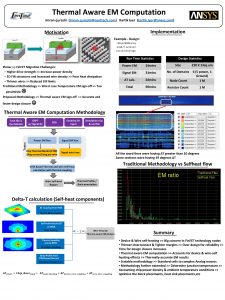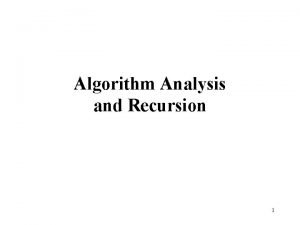Design and Analysis of Algorithm Lecturer Shahid Imran















- Slides: 15

Design and Analysis of Algorithm Lecturer: Shahid Imran

Course Outline • Introduction; Asymptotic notations; Recursion and recurrence relations; • Divide-and-conquer approach; Sorting; Search trees; Heaps; Hashing; Greedy approach; • Dynamic programming; Graph algorithms; Shortest paths; Network flow; Disjoint Sets; • Polynomial and matrix calculations; String matching; NP complete problems; • Approximation algorithms. • Recommended Book: Introduction to Algorithms /2 E, T. H. Cormen

Origin of Algorithm • The word Algorithm comes from the name of the Muslim author Abu Ja’far Mohammad ibn Musa Al-Khowarizmi.

Definition • An algorithm is any well-defined computational procedure that takes some values, or set of values, as input and produces some value, or set of values, as output. • An algorithm is thus a sequence of computational steps that transform the input into output.

Before we start • Data Structure • • • Data Structure is way to process and manipulate data through set of operations Refer to Temporary and manipulation of data i. e. Variable and Array • Database • • Refer to permanent and manipulation of data i. e MS-Access, My. SQL

A Simple Program main () { int a, b, c; a=10; b=20; c=a+b; cout<<“Sum is=“<<c; }

Types of Data Structures According to presentation of data 1. Linear Data Structure 2. Non-Liner Data Structure 1. Sequential Data Structures 1. Array 2. Queue 3. Stack 2. Pointer Data Structure (Linked List) 1. Tree 2. Graph

Types of Data Structures • According to Memory Representation • Logical Data Structure Map data according to partition structure of memory • i. e. One dimensional Array • Physical Data Structure Cannot Map data easily according to partition structure of memory • 2 dimensional array, Tree • A special methods is needed to convert physical data structure to logical data structure

Common Operations on all Data Structures • Insert • Delete • Sort • Search • Merage • Traversing (Scanning)

Array • Linear & Sequential • Array is combination of homogenous elements with • • N Consecutive index numbers (such as 1, 2, 3, 4…. ) Successive memory locations (102, 104, 106, …) • Two types of Array are commonly used • • 1 Dimensional (1 -D) 2 Dimensional (2 -D) • Dope Vector methods is used to convert 2 -D Array into 1 -D.

Stack • It is linear and sequential • Work on following Principles • LIFO (Last in First Out) FILO (First in Last Out) • Two conditions are • Overflow • underflow

Queue • It is linear and sequential • Work on following Principles • FIFO (First in First Out) LILO (Last in Last Out) • Two conditions are • • Overflow Underflow • • • Circular Priority Double Ended • Types of Queue

Linked List • Linear & Pointer • Each element of linked list represented through a node which have 2, 3, or more parts depends upon the type of Linked List • Types of Linked List • One Way (Single) • Two Way (Double)

Tree • Non-Linear Data Structure • Each element of Tree represented through a node which have 2, 3, or more parts depends upon the type of Tree • Types of Tree • General Tree • Binary Tree • B+ Tree • Balance & unbalance Tree

Graph • Non-Linear Data Structure • Each element of Graph represented through a node • Types of Graph • Connected Graph • Weighted Graph
 Lecturer's name
Lecturer's name Shahid ghori
Shahid ghori Shahid arju moni govt. secondary school
Shahid arju moni govt. secondary school Bsmit
Bsmit Shahid sattar aptma
Shahid sattar aptma Dr shahid mansoor
Dr shahid mansoor Nabil shahid
Nabil shahid Shahid hussain psychiatrist
Shahid hussain psychiatrist Shahid sattar aptma
Shahid sattar aptma Anjum asim shahid rahman
Anjum asim shahid rahman Jordan fox passif
Jordan fox passif Salicylism
Salicylism Physician associate lecturer
Physician associate lecturer Spe distinguished lecturer
Spe distinguished lecturer Hello teacher good afternoon
Hello teacher good afternoon Photography lecturer
Photography lecturer





























